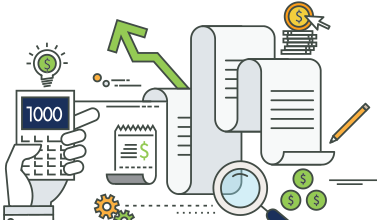
PCAs receive an A grade on both quality control
and customer satisfaction
Washington, D.C. (September 10, 2018) – Today, the U.S. Treasury Inspector General for Tax Administration (TIGTA) released a report that shares the first quality control and customer satisfaction ratings for the private collection agencies (PCAs) working in partnership with the Internal Revenue Service (IRS) to support the Private Debt Collection (PDC) program. In addition to the program succeeding in generating revenue for the Treasury and IRS in the first year of operation, the TIGTA data shows that with regard to both quality control and customer satisfaction the PCAs receive A-level scores.
For consistent management and oversight of the PDC program, the IRS has established a performance measurement system to assess program success. The system analyzes both the quality of program and the satisfaction of customers participating in the program (page 41-42 of the report). The PCA quality scores are:
Customer Accuracy: 99.7 percent
Professionalism: 99.9 percent
Timeliness: 99.8 percent
Regulatory Accuracy: 98.5 percent
Procedural Accuracy: 97.2 percent
In addition to the assessment of program quality, the IRS uses a 3rd party vendor to offer participating taxpayers a short survey to assess customer satisfaction. The PCAs received a combined customer satisfaction score of 92.7 percent.
“We generally agree with the IRS response to the TIGTA report and are happy to finally be able to share the very positive assessment of the Private Debt Collection Program,” said Kristin Walter, spokesperson for the Partnership for Tax Compliance. “The PDC program is clearly working effectively for the U.S. Treasury, for the IRS and for participating taxpayers.”
The PDC Program, mandated by Congress in 2015 and launched in April 2017, seeks to expand the customer service capacity of the IRS to offer a segment of taxpayers – those with uncontested tax underpayments – a variety of manageable and purely voluntary payment plans to help them pay down their tax obligations. These are accounts that would otherwise not have been contacted by the IRS previously due to staff shortages.
Based on data reported by the IRS through the end of June 2018, the PDC Program is fully cash positive after the first year of operation and projections indicate that trend will continue going forward.
The PDC program has brought in more than $56 million in tax revenue for the U.S. Treasury and that total costs – upfront capital investments, commissions paid, and oversight – have totaled approximately $55 million. The data also indicate that after paying for oversight costs, year one revenue generated by the PDC program has provided the IRS with $9 million in a “Special Compliance Personnel Program Fund” to hire and train new IRS personnel later this calendar year.
The PDC program was implemented slowly and cautiously over the course of the first year to ensure adherence to IRS rules and procedures. As the IRS now begins to expand the PDC program, as required by Congress, there will be additional program investments, however the revenue collected is expected to continue to significantly increase, based on IRS projections.
As the federal government struggles to fund infrastructure improvements and sustain entitlement programs, the IRS estimates that the tax gap – the difference between federal taxes owed and those paid each year – exceeds $400 billion. In addition, workforce shortages at the IRS have caused thousands of accounts in arrears to sit untouched for years, with billions lost as accounts age out of a 10-year statute of limitations. Resolving these resource issues and reducing a portion of the tax gap will provide the government with resources to hire staff and fund new and existing federal initiatives.
PDC contractors are limited to calling the assigned taxpayers in arrears and offering to facilitate payment arrangements tailored to their ability to pay. Taxpayers that set up payment arrangements via the PDC Program do not have to pay a “set up fee” of up to $225, as they would, when entering an installment plan directly with the IRS.
If a taxpayer shares that they cannot pay their tax obligation, even over time through a payment plan, they are removed from the PDC program and their account is referred back to the IRS. Taxpayers participating in the PDC Program also have the ability to restructure their payment plans along the way if their circumstances change.
This successful public/private partnership works to bolster the U.S. Treasury, strengthen the effectiveness of the Internal Revenue Service (IRS) and ensure fairness in the federal tax system.
The program requires that more than 50 percent of the funds collected go to the U.S. Treasury with another 25 percent of the collected funds going to the IRS to expand their internal collection capabilities. PDC contractors are subject to the same oversight as IRS agents. Contractor calls are monitored by the IRS and contractors are graded on implementation of taxpayer rights, customer service, statutory and contract requirements.
Related Post
Coalition formed to champion...
IRS’ private sector partners in tax recovery efforts commit to increased transparency,...
- June 26, 2018
- By partnershipftcadmin
- Featured Announcements
Taxpayer Advocate Service...
Taxpayer Advocate Service misleads Congress about the IRS Private Debt Collection Program...
- July 9, 2018
- By Kristin Walter
- Featured Announcements
Year 1 results: IRS Private...
Year 1 results: IRS Private Debt Collection Program successfully boosts agency and U.S....
- August 22, 2018
- By Kristin Walter
- Featured Announcements
IRS Private Debt Collection...
IRS Private Debt Collection Program raises $88.7 million Doubles revenue generated for...
- October 30, 2018
- By Kristin Walter
- Featured Announcements
Innovative IRS payment plans...
Innovative IRS payment plans help make a dent in the tax gap Washington, D.C. (November...
- November 28, 2018
- By Kristin Walter
- Featured Announcements
IRS Private Debt Collection...
IRS Private Debt Collection Program brings in $130.6 million in tax revenue previously...
- March 12, 2019
- By Kristin Walter
- Featured Announcements


